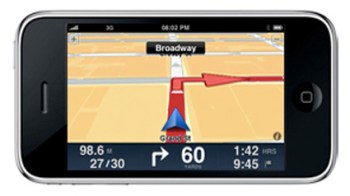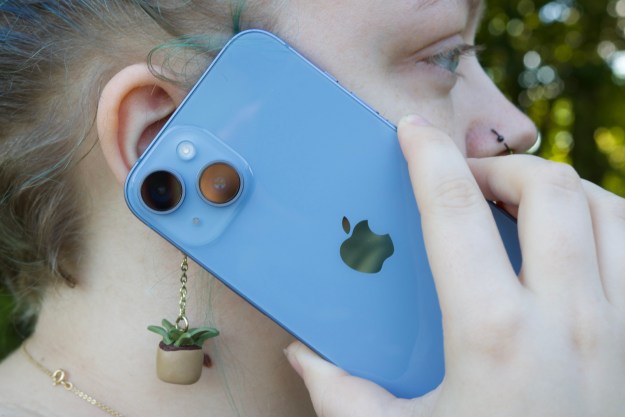
The iPhone comes as close as you can get to a universal, do-everything device. It’s as much a personal media player, translator, Internet tablet, notepad, alarm clock and a dozen other things as it is a cell phone. But with the introduction of the very first turn-by-turn GPS apps from companies like TomTom and Navigon, I think we’re finally seeing the miracle device stretched a little thin.
I’m as much a believer in convergence as any died-in-the-wool nerd, and I take no particular pride in owning a box full of gadgets that do different things when one can fulfill them all. But as more and more functions get packed into the same little rectangle, the specialization that makes every individual device so good at what it does starts to fade. Having played with Navigon’s new iPhone GPS app, and some of its most sophisticated standalone units, I’m now even more convinced. Here’s why the iPhone will never replace the standalone GPS:
Screen Size
As a smartphone, the iPhone’s 3.5-inch screen represents one spacious acre – a roomy residential lot you wouldn’t have much problem planting a nice homestead on. Using it as a GPS navigator is like trying to use the same acre for raising cows. Same space, not really so spacious anymore.

Every manufacturer offers budget navigators in the 3.5-inch class, but that’s really considered the bare minimum for a navigation unit, and after deducting the iPhone’s top status bar from the usable screen area, it gets even smaller. Dedicated navigation units tend to get comfortable at 4.3 inches, downright spacious at 5 inches, and if you’re really looking for a birds-eye lay of the land, they can stretch even larger. Navman offers a massive 7-inch navigator, and in-dash DVD players that come with built-in GPS also routinely reach that size. Not only do directions and maps look crystal clear and easy to use at that size, interacting with the touch screens gets much easier, too.
Plant the iPhone in your windshield, and you’re looking at one tiny navigator.
Price
The companies releasing GPS iPhone apps, like TomTom and Navigon, are the same ones that stand to lose money if you don’t buy standalone navigators. And they’ve priced the apps to ensure they still line their coffers adequately.
Currently, TomTom sells its North American navigation app for $100, and the Western European version for $140. Navigon’s respective apps go for $90 and $140. Of course, in order to comfortably use either one, you’ll need to drop another $60 for Navigon’s iPhone mount. TomTom hasn’t yet priced its own mount, but considering it will include both an upgraded GPS chip and speaker, it will likely cost even more. Even using Navigon’s $90 North American app and the $60 for a conservative estimate, that’s at least a $150 investment to simply add GPS functionality to a device you already paid for.

Call me crazy, but why would I spend that kind of money when I could get a standalone TomTom One Third Edition – a reliable unit that I used to drive 2,700 miles across the country last year – for $82? Or, perhaps more realistically, TomTom’s more up-to-date One 125 runs for $120. And if I wanted to splurge and get a nice spacious 4.3-inch screen, TomTom’s ONE XL 330 goes for $180. For nearly the same price, I get a dedicated screen, speaker, suction cup mount, and charger, and even a USB data cable.
Convenience
After I stash my standalone GPS navigator in my glove box, I have my trusty never-get-lost device with me everywhere, all the time. It lends some piece of mind, the same way a spare tire and a jack in the trunk do. Although I try to my best to do the same with my iPhone, which is well on its way to becoming an extra appendage, it doesn’t always work that way. Sometimes I forget it. Sometimes I don’t want it, like when I’m heading out for a run. Sometimes the battery is just tapped out and it needs to stay at home to charge. When I end up taking a wrong turn into the middle of nowhere on what was supposed to be an easy two-hour car ride, the iPhone in the pocket is a gamble, the GPS in the glove box is a sure bet.
Theft Potential
Having had my car window smashed in and a review GPS system whisked away after I left the mount visible in the car, I do my best to hide GPS systems when I park my now. They’re theft magnets. But if I forget, I would rather have a GPS system perilously hanging in my window attracting thieves, than my iPhone, which has everything from photos to phone numbers, addresses and e-mails in it.
Even if I garaged my car every night and parked in only the yuppiest of neighborhoods under security cameras, the possibility of forgetting my phone in my car because I last used it for navigating stands out as recurring headache for me. Even taking it out of the window at every stop on a long car trip – to go use the bathroom at a gas station for instance – strikes me as a hassle. And if I’m too lazy to hook it up to a charger while it’s in use, I can look forward to a dead phone battery when I get back, too.
No Multitasking
If I’m in the car, I have plenty of other uses for my iPhone, especially on a long ride. I might, for instance want to play some music through an FM transmitter, which I can’t attach if I’m already using a GPS dock. And although I can’t quite bust out a game of Chopper behind the wheel or read the New York Times, passengers always seem to appreciate borrowing the iPhone for a little entertainment on those 10-hour hauls – the same kind you typically use a GPS for.
Conclusion
The old saying about being everything to everyone hold’s true: You can’t do it, and the iPhone’s turn-by-turn GPS apps prove it. Sorry Apple, you can’t win ’em all.
Editors' Recommendations
- This is the iPhone concept of my dreams
- Best phone deals: Save on the iPhone, Galaxy Z Fold 5, and more
- Apple has quietly killed its cheapest iPad
- I found an amazing new way to use my iPhone 15 Pro Max
- One of the most iconic iPhone accessories is back — and it’s great


